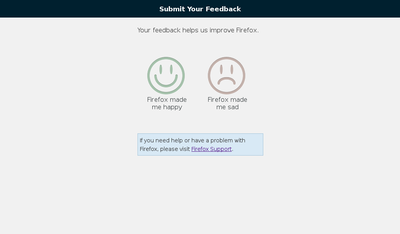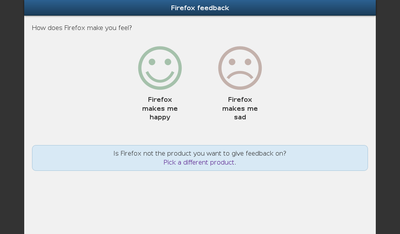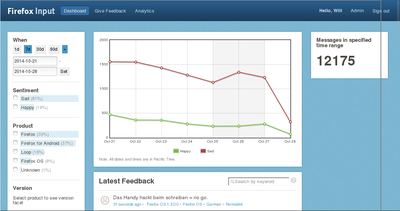ce95161 Clarify source and campaign parameters in API
286869e [bug 788281] Add update_product_details to deploy
bbedc86 [bug 788281] Implement basic events API
1c0ff9f [bug 1071567] Update ElasticUtils to 0.10.1
7fd52cd [bug 1072575] Rework smart_timedelta
ce80c56 [bug 1074276] Remove abuse classification prototype
7540394 [bug 1075563] Fix missing flake8 issue
11e4855 [bug 1025925] Change file names (Adam Okoye)
23af92a [bug 1025925] Change all instances of fjord.analytics.tools to fjord.analytics.utils (Adam Okoye)
ae28c60 [bug 1025925] Change instances of of util relating to fjord/base/util.py (Adam Okoye)
bc77280 Add Adam Okoye to CONTRIBUTORS
545dc52 [bug 1025925] Change test module file names
fc24371 [bug 1041703] Drop prodchan column
9097b8f [bug 1079376] Add error-email -> response admin view
d3cfdfe [bug 1066618] Tweak Gengo account balance warning
a49f1eb [bug 1020303] Add rating column
55fede0 [bug 1061798] Reset page number Resets page number when filter checkbox is checked (Adam Okoye)
1d4fd00 [bug 854479] Fix ui-lightness 404 problems
a9bf3b1 [bug 940361] Change size on facet calls
c2b2c2b [bug 1081413] Move url validation code into fjord_utils.js Rewrote url validation code that was in generic_feedback.js and added it to fjord_utils.js (Adam Okoye)
4181b5e [bug 1081413] Change code for url validation (Adam Okoye)
2cd62ad [bug 1081413] Add test for url validation (Adam Okoye)
f72652a [bug 1081413] Correct operator in test_fjord_utils.js (aokoye)
c9b83df [bug 1081997] Fix unicode in smoketest
cba9a2d [bug 1086643] [bug 1086650] Redo infrastructure for product picker version
e8a9cc7 [bug 1084387] Add on_picker field to Product
2af4fca [bug 1084387] Add on_picker to management forms
1ced64a [bug 1081411] Create format test (Adam Okoye)
00f8a72 Add template for mentored bugs
e95d0f1 Cosmetic: Move footnote
d0cb705 Tweak triaging docs
d5b35a2 [bug 1080816] Add A/B for ditching chart
fa1a47f Add notes about running tests with additional warnings
ddde83c Fix mimetype -> content_type and int division issue
2edb3b3 [bug 1089650] Add a contribute.json file (Bhargav Kowshik)
d341977 [bug 1089650] Add test to verify that the JSON is valid (Bhargav Kowshik)
dcb9380 Add Bhargav Kowshik to CONTRIBUTORS
7442513 Fix throttle test
f27e31c [bug 1072285] Update Django, django-nose and django-cache-machine
dd74a3c [bug 1072285] Update django-adminplus
ececdf7 [bug 1072285] Update requirements.txt file
6669479 [bug 1093341] Tweak Gengo account balance warning
f233aab [bug 1094197] Fix JSONObjectField default default
11193d7 Tweak chart display
9d311ca Make journal.Record not derive from ModelBase
f778c9d Remove all Heartbeat v1 stuff
e5f6f4d Switch test__utils.py to test_utils.py
cab7050 [bug 1092296] Implement heartbeat v2 data model
5480c42 [bug 1097352] Response view is viewable by all
46b5897 [bug 1077423] Overhaul generic feedback form dev
da31b47 [bug 1077423] Update smoke tests for generic feedback form dev
e84094b Fix l10n email template
d6c8ea9 Remove gettext calls for product dashboards
e1a0f74 [bug 1098486] Remove under construction page
032a660 Fix l10n_status.py script history table
19cec37 Fix JSONObjectField
430c462 Improve display_history for l10n_status
d6c18c6 Windows NT 6.4 -> Windows 10
73a4225 [bug 1097847] Update django-grappelli to 2.5.6
4f3b9c7 [bug 1097847] Fix custom views in admin
3218ea3 Fix JSONObjectfield.value_to_string
67c6bf9 Fix RecordManager.log regarding instances
a5e8610 [bug 1092299] Implement Heartbeat v2 API
17226db [bug 1092300] Add Heartbeat v2 debugging views
11681c4 Rework env view to show python and django version
9153802 [bug 1087387] Add feedback_response.browser_platform
f5d8b56 [bug 1087387] [bug 1096541] Clean up feedback view code
c9c7a81 [bug 1087391] Fix POST API user-agent inference code
4e93fc7 [bug 1103024] Gengo kill switch
de9d1c7 Capture the user-agent
4796e4e [bug 1096541] Backfill browser_platform for Firefox dev
f5fe5cf [bug 1103141] Add experiment_version to HB db and api
98c40f6 [bug 1103141] Add experiment_version to views
0996148 [bug 1103045] Create a menial hb survey view
965b3ee [bug 1097204] Rework product picker
6907e6f [bug 1097203] Add link to SUMO
e8f3075 [bug 1093843] Increase length of product fields
2c6d24b [bug 1103167] Raise GET API throttle
d527071 [bug 1093832] Move feedback url documentation
6f4eb86 Abstract out python2.6 in deploy script
f843286 Fix compile-linted-mo.sh to take pythonbin as arg
966da77 Add celery health check
1422263 Add space before subject of celery health email
5e07dbd [heartbeat] Add experiment1 static page placeholders
615ccf1 [heartbeat] Add experiment1 static files
d8822df [heartbeat] Add SUMO links to sad page
3ee924c [heartbeat] Add twitter thing to happy page
d87a815 [heartbeat] Change thank you text
06e73e6 [heartbeat] Remove cruft, fix links
8208a72 [heartbeat] Fix "addons"
2eca74c [heartbeat] Show profile_age always because 0 is valid
4c4598b [bug 1099138] Fix "back to picker" url
b2e9445 Add note about "Commit to VCS" in l10n docs
9c22705 Heartbeat: instrument email signup, feedback, NOT Twitter (Gregg Lind)
340adf9 [heartbeat] Fix DOCTYPE and ispell pass
486bf65 [heartbeat] Change Thank you text
d52c739 [heartbeat] Switch to use Input GA account
f07716b [heartbeat] Fix favicons
eff9d0b [heartbeat] Fixed page titles
969c4a0 [heartbeat] Nix newsletter form for a link
dce6f86 [heartbeat] Reindent code to make it legible
dad6d82 [bug 1099138] Remove [DEV] from title
4204b43 fixed typo in getting_started.rst (Deshraj Yadav)
7042ead [bug 1107161] Fix hb answers view
a024758 [bug 1107809] Fix Gengo language guesser
808fa83 [bug 1107803] Rewrite Response inference code
d9e8ffd [bug 1108604] Tweak paging links in hb data view
00e8628 [bug 1108604] Add sort and display ts better in hb data view
17b908a [bug 1108604] Change paging to 100 in hb data view
39dc943 [bug 1107083] Backfill versions
fee0653 [bug 1105512] Rip out old generic form
b5bb54c Update grappelli in requirements.txt file
f984935 [bug 1104934] Add ResponseTroubleshootingInfo model
c2e7fd3 [bug 950913] Move 'TRUNCATE_LENGTH' and make accessable to other files (Adam Okoye)
b6f30e1 [bug 1074315] Ignore deleted files for linting in pre-commit hook (L. Guruprasad)
4009a59 Get list of .py files to lint using just git diff (L. Guruprasad)
c81da0b [bug 950913] Access TRUNCATE_LENGTH from generic_feedback template (Adam Okoye)
9e3cec6 [bug 1111026] Fix hb error page paging
b89daa6 Dennis update to master tip
61e3e18 Add django-sslserver
93d317b [bug 1104935] Add remote.js
ad3a5cb [bug 1104935] Add browser data section to generic form
cc54daf [bug 1104935] Add browserdata metrics
31c2f74 Add jshint to pre-commit hook (L. Guruprasad)
68eae85 Pretty-print JSON blobs in hb errorlog view
8588b42 [bug 1111265] Restrict remote-troubleshooting to Firefox
b0af9f5 Fix sorby error in hb data view
8f622cf [bug 1087394] Add browser, browser_version, and browser_platform to response view (Adam Okoye)
c4b6f85 [bug 1087394] Change Browser Platform label (Adam Okoye)
eb1d5c2 Disable expansion of $PATH in the provisioning script (L. Guruprasad)
59eebda Cosmetic test changes
aac733b [bug 1112210] Tweak remote-troubleshooting capture
6f24ce7 [bug 1112210] Hide browser-ask by default
278095d [bug 1112210] Note if we have browser data in response view
869a37c [bug 1087395] Add fields to CSV output (Adam Okoye)


